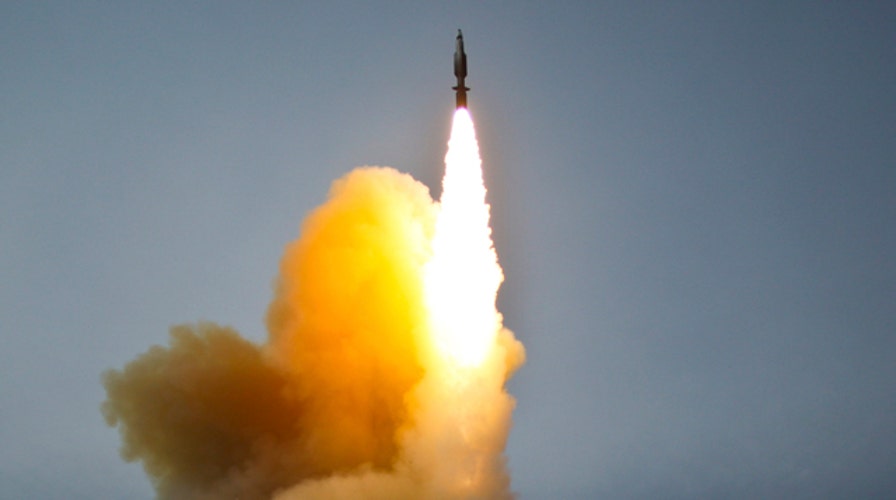Report: North Korea has moved missiles into firing position
David Piper reports from Seoul, South Korea
After successful recent ballistic and nuclear bomb tests, North Korea has threatened the United States with nuclear strikes. This week, the Pyongyang regime stated that the Korean Peninsula is headed for thermo-nuclear war, told foreign diplomats to leave North Korea and advised foreigners to leave South Korea. Today, it has two medium range Musudan-1 missiles prepared for immediate launch from its east coast.
It’s decision time on North Korea.
What should the U.S. do if, as expected, North Korea goes ahead and launches the two Musudan-1 missiles?
[pullquote]
Fortunately, our Aegis Combat System has the ability to calculate their trajectory within seconds. If the Musudan-1 missiles are heading for open water, we should let them fly, but be sure to collect the debris for analysis. Remember, Kim Jong Un’s game is to provoke the United States (and Japan and South Korea) into military action. We should not play into his hands if not necessary.
If, on the other hand, Aegis calculates the trajectory as headed for land (such as Guam, Japan, Okinawa, or South Korea), we need to be prepared to not only take out those missiles with missile interceptors, but also immediately take out their missile launchers with Tomahawks. At that point, we should also take out the eight Musudan missiles the North Koreans are holding in reserve in tunnels along their Eastern coastline.
Earlier this week, Open Source Intelligence (OSINT) detected that North Korea had begun to deploy additional Musudan-1 missiles into firing positions in other parts of North Korea.
North Korea is believed to have between 50-200 Musudan-1 missiles. Its range is a little over 2,500 miles, which is greater than reported by most media outlets. Improvements have been made to some of the Musudans, which include larger fuel tanks and updated navigational and targeting equipment from Russia. There is also concern that some of the Musudans may have been engineered to accommodate a small nuclear warhead.
And don’t forget, the Musudan is just their medium range missile. They also have the Taepodong-2 missile with far greater range.
Even more concerning is their Unha-3 rocket, which successfully put the North Korean satellite in orbit in December. Its range is believed to be 6,200 miles.
On the ground now, in addition to the deployment of more Musudan-1 missiles, the North Koreans are moving large amounts of ammunition, both small caliber and artillery shells, towards both the DMZ and their coastal artillery bases.
Preparations are also underway for a dramatic patriotic military display in North Korea on April 15, the 101st birthday of founder Kim Il-Sung.
All of this occurring while the Chinese have massed the largest mobilization of forces, including missile batteries and tank units, along the North Korean border since the 1950s.
Yes, this is decision time on North Korea. Unfortunately, some of our decisions in recent years, such as gutting missile defense, cutting $1.2 trillion from our defense budget and announcing plans to decommission Missile Field-1(houses missile interceptors) at Fort Greely, Alaska only send the wrong message and invite trouble from dictators like Kim Jong Un.
Fortunately, though, the decisions the United States has made in recent weeks, and continues to make, have been right on the mark.
The Obama administration’s decision to reverse itself and re-open Missile Field-1 at Fort Greely was a good one.
Recent decisions to deploy SBX, a powerful U.S. military sea based radar to detect missile launches and the first operational deployment of THAAD (Terminal High Altitude Area Defense System), the Army’s newest missile defense system, have been the right ones.
We need to continue to deploy both ship and land based missile interceptors and reverse earlier decisions made on missile defense.
Earlier, in an op-ed for Fox News Opinion I called for the establishment of a “Radio Marti-Radio Free Europe” broadcast operation against North Korea from locations in South Korea and Japan. Since that time, there have been multiple reports of division and dissension within the North Korean military over Kim Jong Un. Such a broadcast operation would only help foster that division and dissension, as well as educate the North Korean people.
Lastly, it’s time for America to lead the free world in turning all eyes on China with one unequivocal message: “Quit talking out of both sides of your mouth—you helped create this problem, now it’s time for you to help fix it.”

